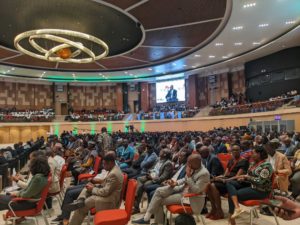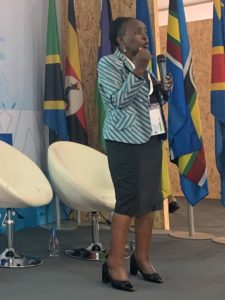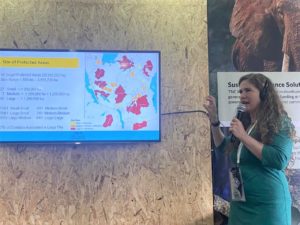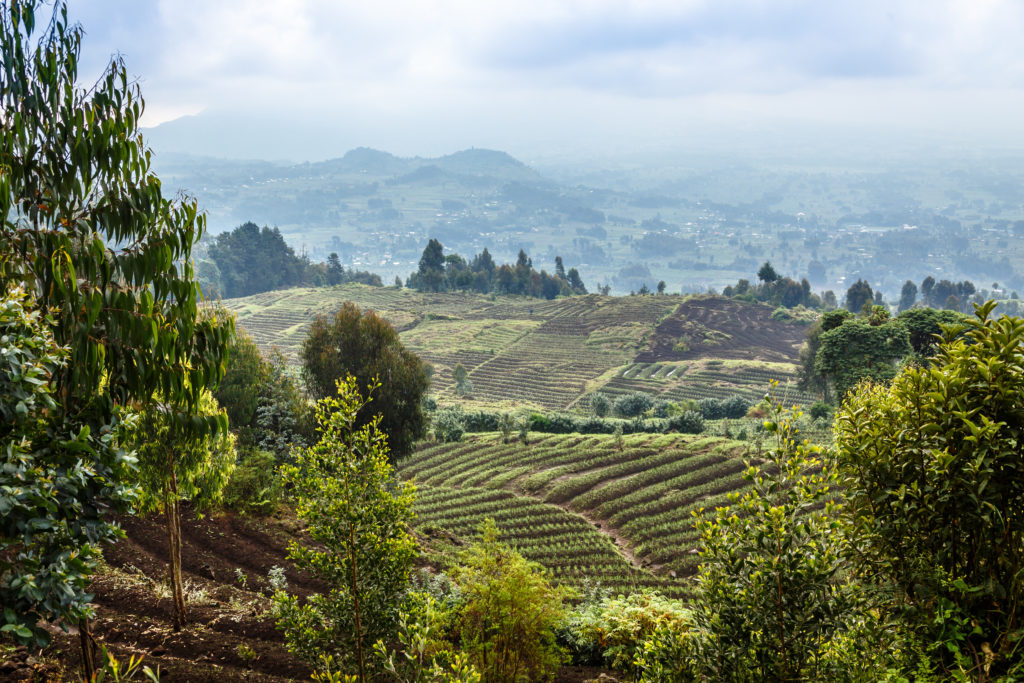
History was made this past summer at the first-ever Africa-wide gathering to discuss the role of protected areas in conserving nature. Hosted in the city of Kigali, Rwanda, the 1st IUCN Africa Protected Areas Congress (APAC) brought together 2,400 participants from across the continent and the world from July 18-23, 2022, under the theme “For People and Nature.” Staff from the Center for Large Landscape Conservation and partners were present in Kigali to highlight the contribution that connectivity conservation is already making, and can make in the future, toward bolstering conservation actions in Africa.
The overarching objective of the inaugural event was to increase the understanding of how parks contribute to biodiversity conservation and delivering ecosystem services, while underpinning human welfare and livelihoods. In addition to giving a number of presentations related to this objective and attending a diversity of keynote speeches, panel discussions, and workshops, Center staff contributed to the preparation and adoption of the Kigali Call to Action for People and Nature (read more below).
Highlights of the Center’s contributions to APAC 2022 are as follows:

The Center co-sponsored an event entitled Connectivity Conservation for Africa: At the Forefront of Conservation Challenges and Solutions at the WWF Pavilion:
- Margaret Kinnaird (Practice Leader for Wildlife at WWF-International) provided opening remarks;
- Megan Parker (the Center’s Conservation Project Director) presented on “Connectivity Conservation for Interconnected Networks of Protected and Conserved Areas”;
- Nyambe Nyambe (Executive Director of the Secretariat for the Kavango-Zambezi Transfrontier Conservation Area (KAZA TFCA) highlighted the area as a model for implementation and adaptive management;
- Lucy Waruingi (Executive Director of the African Conservation Centre) conveyed the importance of Southern Kenya-Northern Tanzania cross-border wildlife movement and future work of the Kenya Corridors Task Force;
- Kristeen Penrod (the Center’s Connectivity Specialist) and Dr. Fortunata Msoffe (Wildlife Division of the Tanzanian Ministry of Natural Resources and Tourism) detailed the forthcoming launch of the Tanzania Wildlife Assessment, Prioritization, and Action Plan;
- Anne Raimat (Director of Biodiversity at Climate Chance) presented a pilot project working to conserve chimp corridors in Guinea through innovative funding mechanisms; and
- Noah Sitati (Wildlife Species Expert at WWF Tanzania) provided insights from the Kenya-Tanzania transboundary Kilimanjaro Landscape.

The Center participated in preparations and events for one of the Congress’ most innovative themes focused on avoiding, minimizing, and mitigating the impacts of infrastructure on the environment. Specific sessions included:
- Infrastructure and Biodiversity: Resilient landscapes – ensuring no net-loss of biodiversity due to infrastructure;
- Infrastructure and People: Sustainable infrastructure for increased benefits to local communities; and
- Infrastructure and Protected and Conserved Areas: Reducing the impact of physical infrastructure on ecosystems and biodiversity in key African landscapes.
The Center co-organized an event at The Nature Conservancy’s Pavilion entitled 30×30 – Connectivity Guidelines and Implementation: Tanzania Case Study that provided a more detailed presentation by Fortunata Msoffe, Kristeen Penrod, and Exper Pius (Deputy Chief of Party for USAID Tuhifadhi Maliasili) about the development of the Tanzania Wildlife Corridor Assessment, Prioritization, and Action Plan.
Kigali Call to Action for People and Nature
On the final day, APAC closed with adoption of the aforementioned Kigali Call to Action for People and Nature, which includes a call for:
“Restoring fragmented and degraded ecosystems and avoiding or mitigating the impacts of climate change, new infrastructure and environmentally destructive activities, thereby maintaining ecological connectivity through networks of protected and conserved areas, including OECMs and transboundary areas.”
As a consolidation of key messages delivered during the Congress, the Call is a commitment by governments and stakeholders to jointly and urgently address the biodiversity, climate change, and health crises through nature-positive outcomes for human development and well-being across Africa. This includes:
- Communicating and implementing the recommendations widely;
- Engaging more with Indigenous Peoples and Local Communities, as well as youth, to collaborate;
- Conveying the recommendations and commitments to the UN Convention on Biological Diversity and the UN Framework Convention on Climate Change to enhance international policy integration;
- Requesting the Africa Union to declare the 18th of July each year to be “Africa Protected and Conserved Areas Day”;
- Developing an African Protected and Conserved Areas Forum to guide implementation and monitoring of the commitments toward convening a 2nd APAC in 4-5 years; and
- Taking action in individual and joint work in participants’ home countries and institutions.
The Congress was convened jointly by the Government of Rwanda, the International Union for the Conservation of Nature (IUCN), and the African Wildlife Foundation (AWF).
Top photo: Green farmlands in Volcanoes National Park, Rwanda. Adobe Stock photo.



